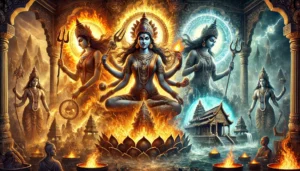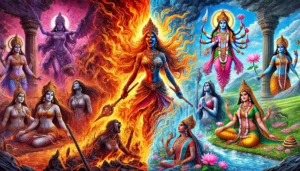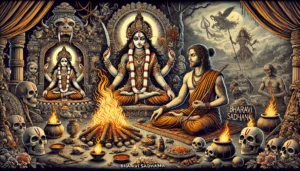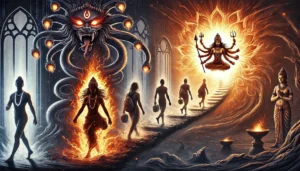Bhairavi Devi: Secrets of the Fierce Goddess’s Powers!
Bhairavi Devi: The Goddess of Fierce Protection, Destruction, and Spiritual Purification
Bhairavi Devi, one of the most formidable goddesses in the Dasha Maha Vidyas, is worshiped for her fierce powers of destruction, protection, and purification. Within Hinduism’s rich pantheon, the Dasha Maha Vidyas are ten forms of the divine feminine, each embodying different aspects of cosmic energy. Bhairavi Devi stands out as the warrior goddess, wielding immense power to destroy ignorance and negative forces while offering protection and purifying her devotees.
In this blog, we will explore Bhairavi Devi’s unique characteristics, compare her to the other Maha Vidyas, discuss famous temples dedicated to her, delve into tantric practices like Bhairavi Devi Sadhana, and understand the significant role she plays in tantric worship. By the end of this deep dive, you’ll gain a greater understanding of how Bhairavi Devi’s transformative power can influence the lives of her practitioners.
1. Introduction to Bhairavi Devi
Bhairavi Devi is revered as one of the fiercest manifestations of the goddess in the Dasha Maha Vidyas, the ten great tantric goddesses. Known for her wrathful form, Bhairavi Devi embodies the terrifying aspect of the divine feminine that confronts negativity head-on. Yet, despite her ferocity, she is immensely compassionate toward her devotees, guiding them toward spiritual growth.
Bhairavi Devi is often depicted in iconography standing in cremation grounds, holding weapons and adorned with skulls. This imagery reflects her association with death and rebirth—important themes in tantric practices where ego and ignorance are “killed” to make way for spiritual evolution. Her role in tantric traditions is significant as she provides the energy necessary to destroy inner and outer obstacles, purifying both the body and soul for the ultimate goal of liberation or moksha.
2. Bhairavi Devi’s Powers: Destruction, Protection, and Purification

Bhairavi Devi’s essence is characterized by three central powers: destruction, protection, and purification. These forces are critical in understanding her role in the spiritual and tantric realms, as each power contributes to the transformation of her devotees.
The Power of Destruction
Bhairavi Devi is most famously known for her power of destruction. However, unlike other mythological figures associated with destruction, Bhairavi Devi’s destructive powers are not chaotic or evil. Rather, they are purposeful and transformative. She destroys ignorance, delusions, and the false ego that prevents spiritual progress. This process is often uncomfortable and challenging, as her energy forces individuals to confront their own limitations, fears, and attachments.
Her form, often depicted with fierce eyes and surrounded by flames or standing amidst cremation grounds, symbolizes her association with death—not in a literal sense, but as a metaphor for the death of ego and attachment to the material world. Bhairavi Devi’s destructive energy makes way for new growth, helping devotees move past superficial aspects of existence to uncover deeper spiritual truths.
The Power of Protection
Though Bhairavi Devi is a fearsome goddess, her fierce nature extends to her role as a protector. In this aspect, she shields her devotees from external dangers, negative energies, and internal struggles. Bhairavi Devi’s protection is said to be especially potent for those who are undergoing significant challenges, whether in their personal lives or spiritual journeys. She is often invoked during times of crisis to remove obstacles or to help devotees overcome fear.
Moreover, Bhairavi Devi’s protective energy extends beyond just shielding from harm. It also empowers her devotees with confidence and inner strength, allowing them to face challenges with courage. Her ferocity becomes a force that devotees can channel in their own lives to break free from limitations and walk their paths with determination and assurance.
The Power of Purification
Purification is perhaps one of Bhairavi Devi’s most transformative powers. Through her energy, devotees experience a deep cleansing of both body and soul. Bhairavi Devi ’s purification process involves burning away karmic impurities, negative emotions, and harmful thought patterns, all of which hinder spiritual progress. In tantric traditions, the process of purification is seen as essential to awakening higher consciousness, and Bhairavi Devi is the catalyst that makes this possible.
Her purifying energy is believed to clear blockages in the body’s chakras, allowing the flow of spiritual energy to move unhindered through the practitioner. Through Bhairavi Devi’s purification, devotees emerge renewed, ready to pursue higher spiritual goals with clarity and focus.
3. Bhairavi Devi vs. Other Maha Vidyas: What Sets Her Apart?

In the cosmic lineup of the Dasha Maha Vidyas, each goddess represents a unique aspect of the divine feminine, and Bhairavi Devi is distinguished by her fiery, intense energy. Unlike Tripura Sundari or Lalita, who are associated with beauty, love, and grace, Bhairavi Devi ’s nature is raw, primal, and uncompromising.
While many of the Maha Vidyas embody the creative or nurturing aspects of the universe, Bhairavi Devi represents its destructive, purifying force. Her association with death, not just as an end but as a necessary part of rebirth and transformation, sets her apart from other deities in the Dasha Maha Vidyas. Bhairavi Devi ’s role is not to comfort or soothe, but to push her devotees beyond their limits, helping them confront the harsh truths of existence and transcend them.
Bhairavi Devi ’s fierce appearance—holding weapons, adorned with a garland of skulls, and standing on a corpse—may be intimidating, but it symbolizes her deep connection to the ultimate reality: that death and destruction are essential for transformation. Her form and energy break down the ego and burn away ignorance, making her a central figure in tantric practices where personal transformation and liberation are the goals.
4. Famous Bhairavi Devi Temples: Kamakhya Temple and Beyond

Bhairavi Devi is widely worshipped across India, especially in temples that are important centers of tantric practice. These temples are not just places of worship but are believed to be power spots imbued with divine energy, making them ideal for conducting rituals and spiritual practices aimed at invoking Bhairavi Devi’s transformative powers.
Kamakhya Temple, Assam
One of the most famous and powerful temples dedicated to Bhairavi Devi is the Kamakhya Temple, located on Nilachal Hill in Guwahati, Assam. While the temple is primarily dedicated to the goddess Kamakhya, a form of Shakti, Bhairavi Devi is also worshiped here as one of the ten Maha Vidyas. The Kamakhya Temple is a major center for tantric practices, attracting devotees and tantrics from across the country, especially during the Ambubachi Mela, an annual festival celebrating the goddess’s menstruation, which symbolizes the cycle of creation, preservation, and destruction.
Bhairavi Devi’s presence at Kamakhya is potent, and many tantric practitioners perform Bhairavi Sadhana here to connect deeply with her fierce energy. The temple is considered a Shakti Peetha, one of the sacred spots where parts of the goddess Sati’s body are believed to have fallen, making it a highly charged spiritual location.
Bhairavi Temple, Varanasi
Another significant temple dedicated to Bhairavi is located in Varanasi, one of the most ancient and sacred cities in India. The Bhairavi Temple in Varanasi is located near the Manikarnika Ghat, one of the city’s most renowned cremation grounds. Varanasi is often called the city of death and rebirth, and Bhairavi’s association with cremation grounds makes her temple here particularly significant for tantric worship.
At this temple, devotees and tantric practitioners seek Bhairavi’s blessings for purification and liberation from the cycle of birth and death. The energy of the cremation grounds, combined with Bhairavi’s fierce presence, makes the Varanasi Bhairavi Temple a powerful place for conducting tantric rituals aimed at spiritual transformation and liberation.
Other Notable Bhairavi Temples
Beyond Kamakhya and Varanasi, there are several other important Bhairavi temples across India:
- Tripura Bhairavi Temple, Himachal Pradesh – Located in the tranquil hills of the Himalayas, this temple is a revered spot for tantric practitioners seeking Bhairavi’s blessings. The isolation of the region makes it an ideal place for conducting advanced tantric sadhanas.
- Bhairavi Dham, Uttar Pradesh – Situated in Mirzapur, Bhairavi Dham is another important temple where devotees come to seek Bhairavi’s protection, power, and spiritual guidance. It is also known for its tantric rituals, especially during auspicious festivals.
Each of these temples holds significant energy, and visiting them is said to amplify the effects of Bhairavi Sadhana, helping devotees experience deeper levels of transformation and purification.
5. Tantric Practices of Bhairavi: Bhairavi Sadhana

Tantric practices associated with Bhairavi are rigorous and often conducted in secluded, spiritually charged environments like cremation grounds or dense forests. One of the most profound of these practices is Bhairavi Sadhana, a tantric discipline that invokes the goddess’s fierce energy for spiritual transformation.
Overview of Bhairavi Sadhana
Bhairavi Sadhana is a powerful practice that involves intense concentration, visualization, and mantra chanting to invoke Bhairavi’s presence. This sadhana is considered one of the more advanced tantric disciplines due to the level of dedication and mental focus required. Often guided by an experienced tantric guru, practitioners use Bhairavi Sadhana to break free from limitations, remove obstacles, and purify their minds and bodies.
The ultimate goal of Bhairavi Sadhana is spiritual liberation or moksha. However, practitioners may also perform this sadhana to seek Bhairavi’s blessings for protection, the removal of fears, and the destruction of internal and external enemies.
Rituals of Bhairavi Sadhana
The rituals involved in Bhairavi Sadhana are varied, but some of the most common include:
- Mantra Chanting: The recitation of Bhairavi mantras, such as “Om Bhairavi Bhairavi Namaha”, is essential for invoking the goddess’s energy. Mantras are often chanted for extended periods, with a particular focus on the vibration and resonance of the sound, which helps align the practitioner’s energy with Bhairavi’s.
- Yagna (Fire Rituals): Fire rituals, or yagnas, are often performed during Bhairavi Sadhana to offer oblations and sacrifices to the goddess. These rituals are said to appease Bhairavi and help the practitioner attain her favor.
- Meditation on Bhairavi’s Form: Visualizing Bhairavi’s fierce form is a common meditation practice during this sadhana. Practitioners are encouraged to focus on her fearsome aspects—such as her weapons, skull garland, and fiery gaze—to connect deeply with her energy and integrate it into their own spiritual journey.
Outcomes of Bhairavi Sadhana
Bhairavi Sadhana is known for its profound effects on those who practice it with dedication. Some of the transformative outcomes include:
- Removal of Obstacles: Bhairavi’s energy is believed to dissolve obstacles that block spiritual and material progress. Whether these are internal (such as mental doubts and fears) or external (such as enemies or societal challenges), Bhairavi’s destructive force clears the path.
- Destruction of Ignorance: Bhairavi’s primary role in sadhana is the destruction of ignorance, delusion, and ego. Through her energy, practitioners can see through illusions and reach higher levels of spiritual understanding.
- Empowerment and Confidence: Practitioners who invoke Bhairavi’s energy experience a surge in personal power and confidence. Her fierce energy empowers devotees to face challenges with courage and determination, breaking through their own limitations.
6. The Role of Bhairavi’s Temples in Tantric Worship

Bhairavi’s temples play a crucial role in tantric worship, as they are believed to be imbued with the goddess’s energy. These temples are often considered power spots or Shakti Peethas, where the divine feminine energy is especially strong. The tantric rituals performed in these temples are believed to have amplified effects due to the sacredness of the location and the presence of Bhairavi’s fierce energy.
At Bhairavi’s temples, devotees engage in rituals such as yagnas, mantra chanting, and offerings to invoke her protection and purification. Tantric practitioners may also perform advanced rituals, seeking Bhairavi’s blessings for spiritual empowerment or liberation. The temples, often located near cremation grounds or in secluded areas, provide the ideal environment for these intense practices, which require a deep connection to the divine and the inner self.
These temples are not only places of worship but also centers of transformation, where devotees come to shed their fears, overcome obstacles, and experience personal growth. By visiting Bhairavi’s temples, devotees and tantric practitioners connect with her powerful energy, which helps them achieve deeper states of meditation, purification, and spiritual progress.
7. The Transformative Journey with Bhairavi

In conclusion, Bhairavi’s powers of destruction, protection, and purification offer her devotees and practitioners a profound opportunity for spiritual transformation. Unlike other deities, Bhairavi does not provide comfort or ease but instead challenges her devotees to face their deepest fears and limitations. Through intense tantric practices like Bhairavi Sadhana and by visiting her powerful temples, practitioners can destroy ignorance, remove obstacles, and emerge empowered.
For those who seek Bhairavi’s blessings, her transformative energy is both a challenge and a gift. She is a fierce but compassionate guide who leads her devotees toward the ultimate goal of liberation, providing them with the inner strength and clarity needed to walk their spiritual paths with confidence and courage.
FAQs About Bhairavi and Her Worship
Q: What is the significance of Bhairavi in the Dasha Maha Vidyas? A: Bhairavi is one of the ten tantric goddesses in the Dasha Maha Vidyas. She represents the fierce, transformative power of the divine feminine, responsible for destroying ignorance and purifying the soul.
Q: How does Bhairavi’s destructive energy help devotees? A: Bhairavi’s destructive energy removes obstacles, ego, and ignorance, clearing the way for spiritual growth and enlightenment. Her destruction is transformative, not chaotic, allowing devotees to transcend limitations.
Q: What are the benefits of performing Bhairavi Sadhana? A: Practicing Bhairavi Sadhana can lead to the removal of obstacles, destruction of ignorance, personal empowerment, and spiritual purification. It is a powerful tantric practice aimed at transformation and spiritual liberation.
Q: Where are the most famous Bhairavi temples located? A: Some of the most famous Bhairavi temples include the Kamakhya Temple in Assam, the Bhairavi Temple in Varanasi, and the Tripura Bhairavi Temple in Himachal Pradesh. These temples are powerful centers of tantric worship.
Q: Can anyone perform Bhairavi Sadhana, or does it require special training? A: Bhairavi Sadhana is an advanced tantric practice that often requires the guidance of a guru. While anyone can seek Bhairavi’s blessings, performing the sadhana requires dedication, concentration, and a deep understanding of tantric practices.
Q: What role does Bhairavi play in tantric worship? A: Bhairavi is a central figure in tantric worship, as her energy is essential for transformation. Through rituals, offerings, and sadhana, tantric practitioners invoke Bhairavi’s power to overcome obstacles, purify themselves, and reach higher states of consciousness.



















